GSPhotoCo Visual Studio
Slides
Title
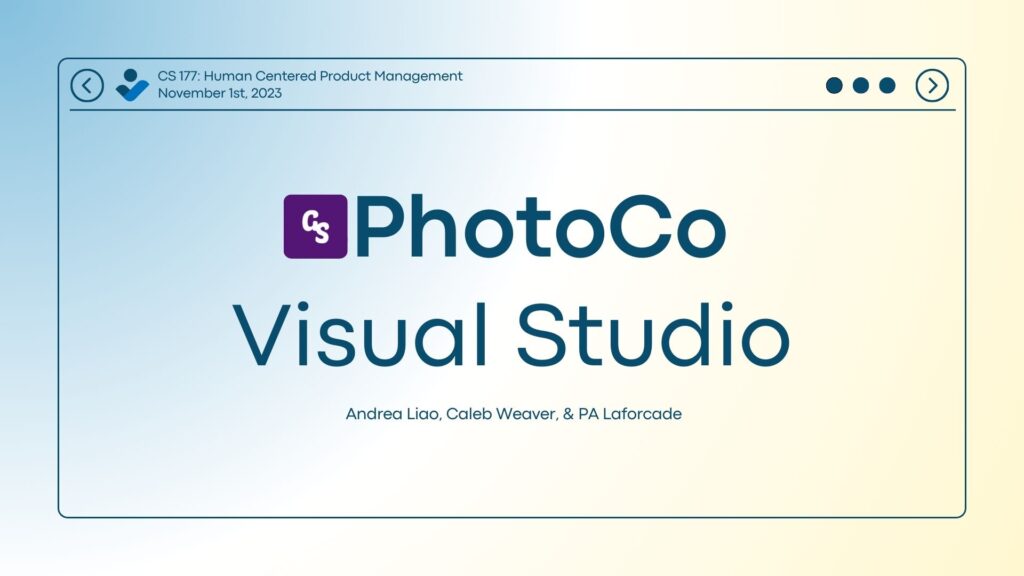
Generic Stock Photo Company (GSPhotoCo) is a leading provider of high-quality stock images, videos, and multimedia assets for a variety of industries, including advertising, marketing, publishing, and design. With a vast collection of diverse and compelling visuals, GSPhotoCo caters to professionals, creative individuals, and businesses looking to enhance their projects and presentations with exceptional imagery.
Team

Andrea Liao: A current undergraduate student at Stanford University studying Human and Computer Interaction in the Computer Science department with a past in graphic and UX design.
PA Laforcade: A current master’s student at Stanford University specializing in MS&E who has a demonstrated history in the past of working in Developer Operations in Tech Startups.
Caleb Weaver: A current undergraduate student at Stanford University studying Systems in the Computer Science department with experience as a full-stack engineer and product manager at several insurance technology startups.
We are the best team to solve this problem because we each come from a unique background with a singular common thread – being on teams requiring us to wear many hats. While on those teams, despite our diverse backgrounds and specializations, we have each felt the sharp pain of needing a beautiful graphic or design quickly and being unequipped to produce what we hoped. This grants us a unique empathy for the problem and insight into the optimal solution. We just want to build the tool we want to use.
Introduction
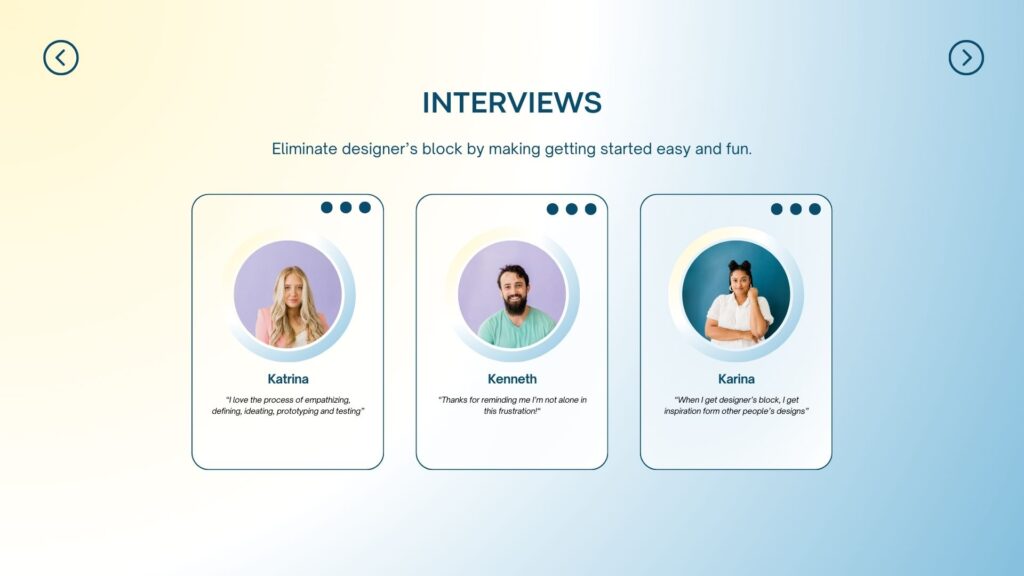
In the $49 billion design industry, every single designer experiences some form of design or creative block. Some only experience it once in their career, others, every week. However, regardless of when, or how, every designer is stumped by the blank canvas at some point. Current editing and creation solutions all start from a blank slate, providing little to no assistance to these stumped and
Problem

Every designer dreads getting started. They face some sort of creative or design block and lose valuable time trying anything from going for a walk to hanging upside down to get unstuck. And though most editing software is trying to incorporate AI elements to enhance the designer workflow, these elements are all focused on making design and editing easier, not getting started. Conversely, generative AI platforms which are capable of creating great starting places for designers, lack the configurability necessary to solve their problem. Their productions are often non-exportable, uneditable and lack cohesive theming. Thus, designers remain stuck.
Solution
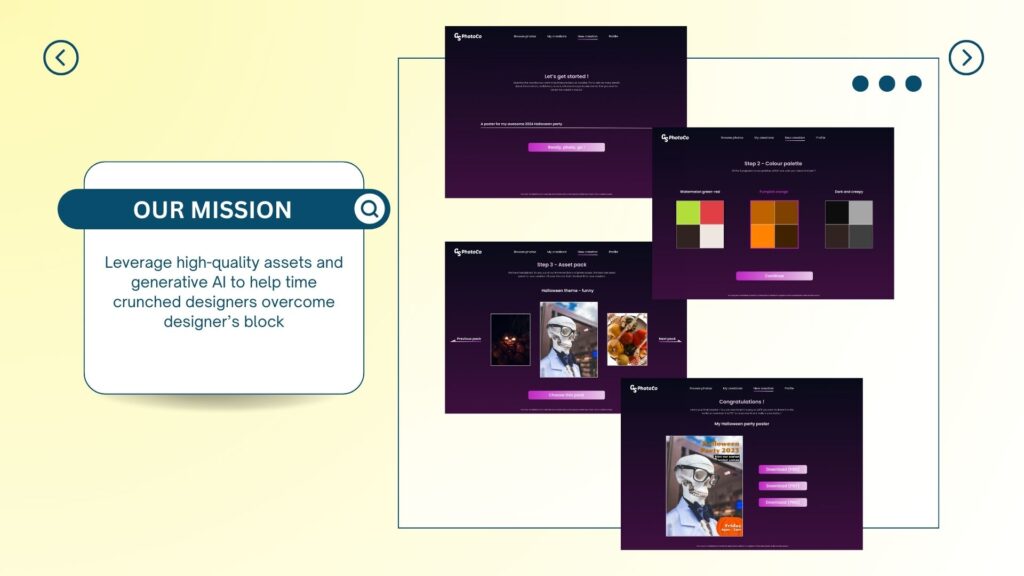
To address the designer’s block, we propose a new extension of the GSPhotoCo media repository which allows shoppers to begin the design process directly after checkout, rather than simply downloading the raw assets.
The visual studio will prompt users during the checkout process. Utilizing a simple, generative AI-powered UX flow, the Visual Studio will guide designers through starting their creation – creating high-quality options of asset combinations, themes, and fonts. The users will then have the ability to export their designs in any format.
Market Analysis: 1

TAM: Global Freelance Market
Calculations: $49.7b total graphic design revenue * 0.9 percent of the market that is freelance / $35/hr as an average hourly rate / 10/project * $2/project
SAM: 10% of the United States Freelance Market
Calculations: $16.6b total graphic design revenue in the United States * 0.9 percent of the market that is freelance * 0.1 percent of market captured / $35/hr as an average hourly rate / 10/project * $2/project
SOM: 50% of current GSPhotoCo freelance designers
Calculations: $150m total GSPhotoCo revenue * 0.75 percent of usage that is professional * 0.9 percent of usage that is freelance / $35/hr as an average hourly rate / 10/project * $2/project
Assumptions:
– $35 avg. for beginner/intermediate graphic designer
– 10 hours per project
– 1 project consists of 1 asset pack (~$2)
– 75% of GSPhotoCo users are professionals
Sources:
- https://my.ibisworld.com/gl/en/industry/l6723-gl/at-a-glance
- https://my.ibisworld.com/us/en/industry/54143/at-a-glance
- https://colorlib.com/wp/graphic-design-statistics/
Market Analysis: 2
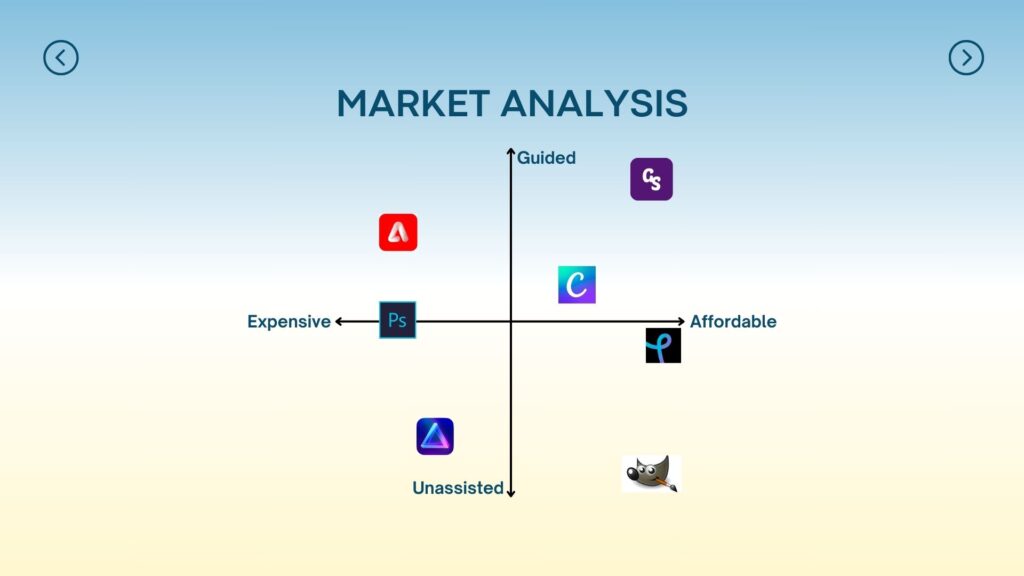
Photoshop: Expensive ($37.99/mo.) with a few AI elements; doesn’t include the ability to create graphics/illustrations, only edit images
Adobe Firefly: Expensive ($37.99/mo.) and though it has many AI elements, they are a disparate suite of tools to be embedded in their existing products, not a standalone, cohesive AI flow; similar to DALL-E
Luminar Neo: Less expensive ($14.95/mo.) and little to no AI elements
Canva: Less expensive ($10/mo.) and a few AI assistance elements
Pixlr: Free but no few AI elements
GIMP: Free, no AI elements
GSPhotoCo: Inexpensive (Free), complete guided process for starting and has the ability to ingest multiple reference/starting assets
Business Model
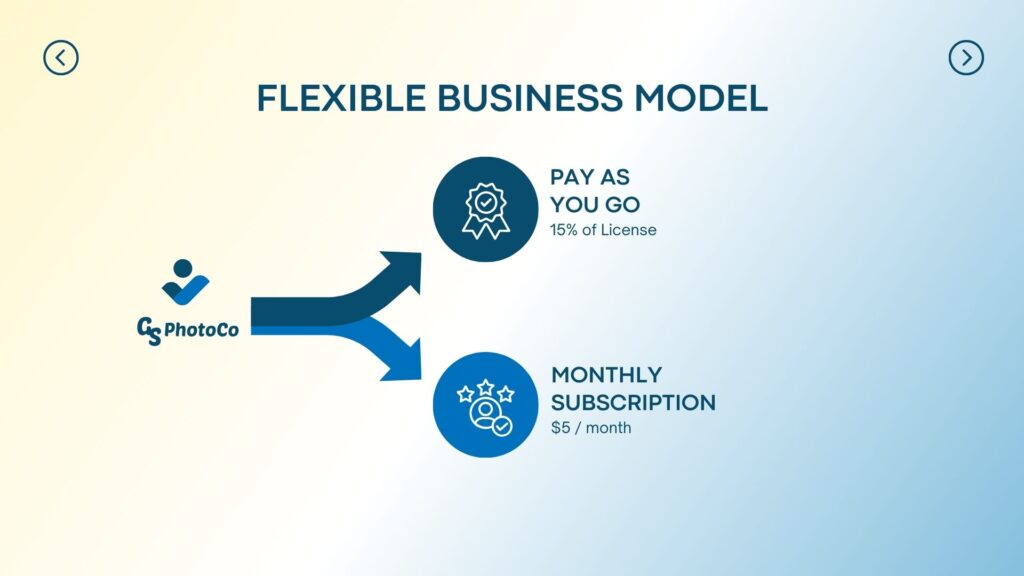
2 Streams of Revenue:
1. User pays a 1 time 15% fee, on top of the asset-pack licensing fee (the average price of an asset pack is ~$15), to utilize the ‘designer’s block’ project creation flow
2. User pays a monthly subscription to utilize the flow on all asset packs as well as upload their own images/assets to use with the stock imagery they purchase
Go-to-Market Strategy
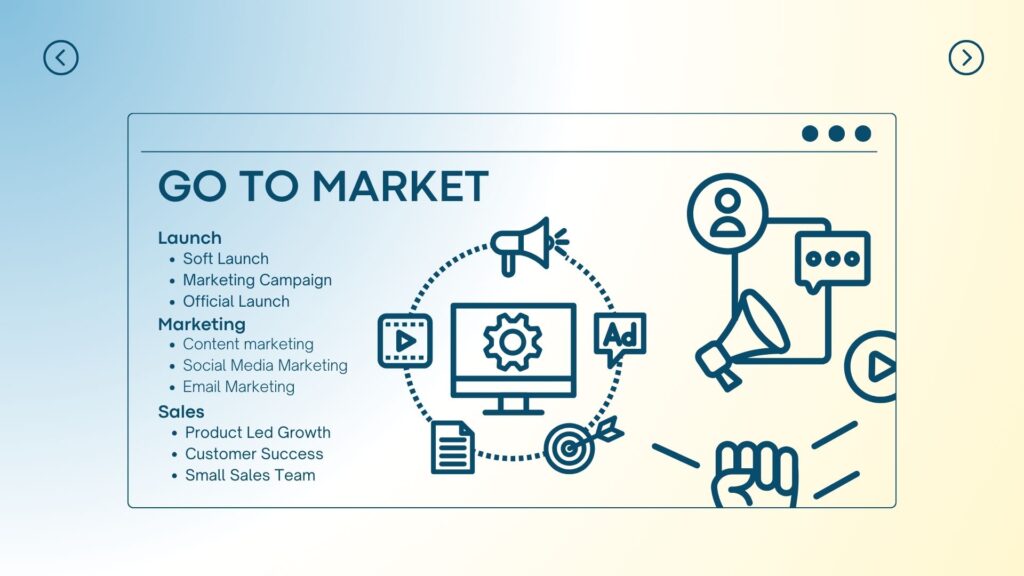
At a high level, our go-to-market strategy is a straightforward Saas product launch that is initially focused on converting existing GSPhotoCo users by leveraging low-resistance product lead features. Once we have collected enough feedback and feel confident in the product, we would then begin branching out to grow the user base with non-GSPhotoCo consumers as well as sell directly to small agencies and pursue strategic partnerships, such as Fiverr.
Launch Strategy:
- Soft Launch: Begin with a soft launch to a select group of beta users, gathering feedback and refining the product based on their input
- Marketing Campaign: Build anticipation through teasers and informative content leading up to the official launch; utilizing social media, email marketing, and online communities to create buzz
- Official Launch: Organize a launch event or webinar to introduce the product to the public, focusing on how we can help eliminate designer’s block
Marketing Strategy:
- Email Marketing: Build an email list from current GSPhotoCo users and use it to send product updates, tips, and special offers to subscribers
- Content Marketing: Create high-quality blog posts, tutorials, and videos that illustrate how the product makes “starting fun”; this includes cross-posting ads on the current GSPhotoCo platform while users continue to shop
- Social Media Marketing: Maintain an active presence on relevant platforms
Sales Strategy:
- Product Lead Growth:
- Customer Success: Offer responsive and knowledgeable customer support to assist users with issues or questions and leverage loyalty programs and special deals to retain users and convert new ones
- Small Sales Team: Deploy a small sales team to sell business subscriptions to small agencies and investigate potential partnerships with gig platforms
Milestones and Timeline

Preparation:
– Create a wireframe prototype to get feedback from customers and user surveys to validate the idea and test UX
Pilot:
– Create a prototype of the product to get core features to our pilot customers
– Launch a first version in production
– Collect live feedback and iterate
Launch:
– Continue collecting and iterating on feedback
– Launch new features
– Prepare for the influx of traffic and activity
Expansion:
– Focus on improving conversion rate from individuals purchasing licenses on GSPhotoCo
– Improve performance and security
– Launch in other regions
Financial Projections
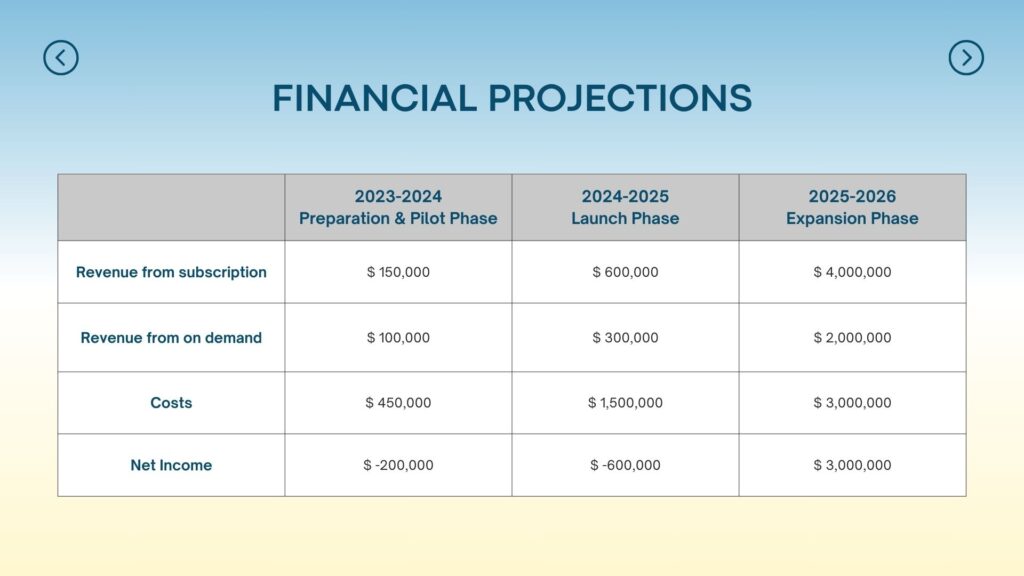
Because our application dovetails with the existing stock media repository, and because we offer a “pay-as-you-need” tier, for users who want to try out the application or only need to use it once, we can project a lot of sales – especially early on – from GSPhotoCo users trying the feature once, but not necessarily subscribing. This is reflected in our projections, where we target a certain amount of recurring revenue through the subscription model, but estimate a subset of the overall user base utilizing the functionality at least once.
On this slide, we conservatively estimate our financial projections for the next 36 months, given the hiring strategy and target subscription and one-time purchases estimated on the previous Milestone slide. This means – again speaking conservatively – we project the ability to capture ~30% of our SAM in 3 years, while also reaching profitability. These projections do not include potential increased licensing costs or additional revenue streams.
Calculations:
- Column 1: Calculations based on Phase 1 & 2 of Milestones and Timeline slide
- Costs: $150,000 * 3 FTEs = $450,000
- Subscription Revenue: 250 subscriptions * 5 * 12 = $150,000
- Pay per-use Revenue: 100,000 GSPhotoCo MAUs * 1 = $100,000
- Net Income: -$200,000
- Column 2: Calculations based on Phase 3 of Milestones and Timeline slide
- Costs: $150,000 * 10 FTEs = $1,500,000
- Subscription Revenue: 10,000 subscriptions * 5 * 12 = $600,000
- Pay per-use Revenue: 300,000 GSPhotoCo MAUs * 1 = $300,000
- Net Income = -$600,000
- Column 3: Calculations based on Phase 3 of Milestones and Timeline slide
- Costs: $150,000 * 20 FTEs = $3,000,000
- Subscription Revenue: 100,000 subscriptions * 5 * 12 = $4,000,000
- Pay per-use Revenue: 2,000,000 GSPhotoCo MAUs * 1 = $2,000,000
- Net Income = $3,000,000
Formulas:
Costs = Payroll + Cloud Costs (negligible) = $150,000*(number of people in the engineering team)
Subscription revenues = (number of monthly subscribed users) * 5 * 12
Pay per use revenues =(number of MAU) * 1
Risk Assessment

We see a majority of the risks to the success of Visual Studio come from within the organization itself. This is because we feel like GSPhotoCo’s diverse, high-quality repository of images, paired with our parent company’s experience with AI searching, grants us a large moat in the space – not to mention our head start. Therefore, we see our main risks as the following:
- Technical Complexity: We may not be able to realize the full extent of the platform due to limitations in our technology or product talent
- Change in Market Conditions: Markets may change or fluctuate in such a way that less marketing or design is required, squeezing the freelance market, and thus, shrinking their market share, revenue, number of projects, and need for a tool like the Visual Studio
- Unclear Requirements: We may not be able to identify a common user journey that we can build against and solve, which would prevent use from building a scalable solution; ie. each designer process is so different, that there is no ‘common starting ground’
- Lack of Resources: GSPhotoCo may not have the initial resources to invest in the project, for the duration of time required, to get the application off the ground
Ask & Next Steps

Our ask for $250k to validate the market and identify potential Product Market Fit. Because we are a cloud-based Saas company with an existing infrastructure to build upon, our startup costs will be low. We would like to allocate the $250k to hiring 1 software engineer and 1 UX designer, to perform additional market research, validation, and prototype testing. After their initial phase, we propose the product council reconvene to review the information collected by the initial research and decide whether or not to move forward.
Numbers:
- Hire 1 software engineer at ~$100k salary
- Hire 1 UX designer at ~$100k salary
- Allocate $50k to the operating budget
Appendix
Business Model Canvas

Reflections
Additional Information
- Pivot: Approximately halfway through the project cycle, our team decided to pivot our product, requiring us to recalculate and re-research our market, TAM/SAM/SOM as well as recreate our BCM, among other things.
- Deck: Our deck is designed to be verbally pitched, not to be used as a leave-behind










